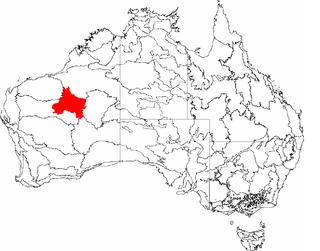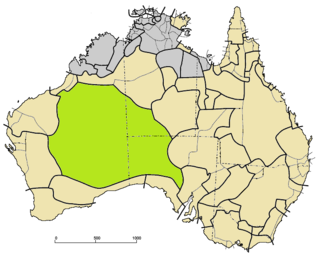
Rabbit-Proof Fence is a 2002 Australian epic drama film directed and produced by Phillip Noyce. It was based on the 1996 book Follow the Rabbit-Proof Fence by Doris Pilkington Garimara, an Aboriginal Australian author. It is loosely based on the author's mother Molly Craig, aunt Daisy Kadibil, and cousin Gracie, who escaped from the Moore River Native Settlement, north of Perth, Western Australia, to return to their Aboriginal families. They had been removed from their families and placed there in 1931.

Wiluna is a small town in the Goldfields-Esperance region of Western Australia. It is situated on the edge of the Western Desert at the gateway to the Canning Stock Route and Gunbarrel Highway. It is the service centre of the local area for the local Martu people, the pastoral industry, the Wiluna Gold Mine, and many more people who work on other mines in the area on a "fly-in/fly-out" basis.

Kumpupintil Lake, formerly known as Lake Disappointment, is an endorheic salt lake located in the Little Sandy Desert, east of the Pilbara region of Western Australia.

The Little Sandy Desert (LSD) is a desert region in the state of Western Australia, lying to the east of the Pilbara and north of the Gascoyne regions. It is part of the Western Desert cultural region, and was declared an interim Australian bioregion in the 1990s.

The State Barrier Fence of Western Australia, formerly known as the Rabbit-Proof Fence, the State Vermin Fence, and the Emu Fence, is a pest-exclusion fence constructed between 1901 and 1907 to keep rabbits, and other agricultural pests from the east, out of Western Australian pastoral areas.

The Western Desert language, or Wati, is a dialect cluster of Australian Aboriginal languages in the Pama–Nyungan family.
Doris Pilkington Garimara, also known as Doris Pilkington, was an Aboriginal Australian author.
The Martu (Mardu) are a grouping of several Aboriginal Australian peoples in the Western Desert cultural bloc.
Looma is an Aboriginal community about 120 km south-east of Derby adjacent the Fitzroy River in the Kimberley region of Western Australia. At the 2011 census, Looma had a population of 374.

Aṉangu Pitjantjatjara Yankunytjatjara, also known as APY, APY Lands or the Lands, is a large, sparsely-populated local government area (LGA) for Aboriginal people, located in the remote north west of South Australia. Some of the Aṉangu (people) of the Western Desert cultural bloc, in particular Pitjantjatjara, Yankunytjatjara and Ngaanyatjarra peoples, inhabit the Lands.

Kunawarritji is an Aboriginal community, located in the Pilbara region of Western Australia, within the Shire of East Pilbara on the Canning Stock Route.

Parnngurr is a medium-sized Aboriginal community, located 370 km from Newman in the Pilbara region of Western Australia, within the Shire of East Pilbara. Parnngurr was originally known as Cotton Creek, the name of the ephemeral creek that runs beside the community.

Punmu is an Aboriginal community, located 640 km south east of Port Hedland in the Pilbara region of Western Australia, within the Shire of East Pilbara.
Balfour Downs Station is a pastoral lease and cattle station located approximately 132 kilometres (82 mi) northeast of Newman, 88 kilometres (55 mi) east of Roy Hill and 108 kilometres (67 mi) southeast of Nullagine in the Pilbara region of Western Australia. At 6,395 square kilometres (2,469 sq mi), it is among the largest cattle stations in Australia.
Parnpajinya is a small Aboriginal community, located proximate to Newman in the Pilbara region of Western Australia, within the Shire of East Pilbara.
Martu Wangka is a variety of the Western Desert language that emerged during the 20th century in Western Australia as several Indigenous communities shifted from their respective territories to form a single community.
Molly Kelly was an Australian Martu Aboriginal woman, known for her escape from the Moore River Native Settlement in 1931 and subsequent 1,600 km (990 mi) trek home with her half-sister Daisy Kadibil and cousin Gracie Cross. She was a member of the Stolen Generations, who were part-white, part-Aboriginal children forcibly removed from their families by the Australian government. Her story was the inspiration for the book Follow the Rabbit-Proof Fence and the film Rabbit-Proof Fence.
The Kartudjara are an Aboriginal Australian people of the Pilbara region of Western Australia.
The Wirdinja were an Aboriginal Australian people of the Pilbara region of Western Australia.

Daisy Kadibil was an Aboriginal Australian woman whose experiences shaped the 1996 book Follow the Rabbit-Proof Fence, written by her niece Doris Pilkington Garimara and the subsequent 2002 film Rabbit-Proof Fence.











